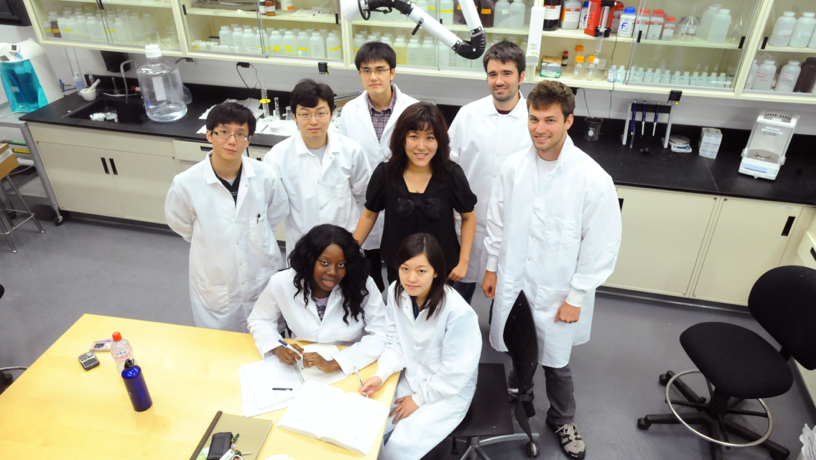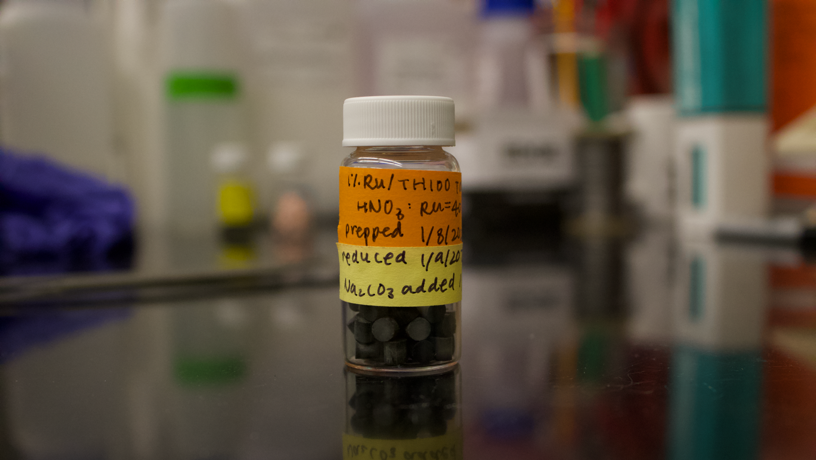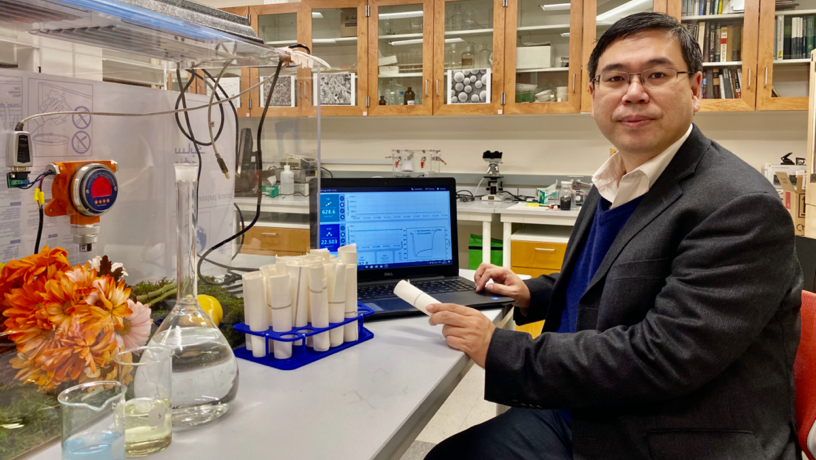Out of Thin Air
Technologies that capture and store freely circulating CO2 can play a crucial role in mitigating global warming

Park, center, with members of her lab.

DFM pellets.
The concentration of carbon dioxide in our atmosphere hovers right around 415 ppm; based on worst case scenario estimates from the Scripps Institute of Oceanography, it could reach 500 ppm by 2050. But even if the numbers stabilize around 450 ppm and we transition from fossil fuels to renewable sources of power tomorrow, 20% to 35% of the carbon dioxide humans have already emitted into the atmosphere could persist for two to twenty centuries—and continue to drive climate change.
To effectively curb global warming we’ll need new technologies, carefully engineered to react directly with this freely circulating carbon dioxide, pulling it from thin air before its impacts have a chance to manifest.
Earth and Environmental Engineering Professor of Practice Robert Farrauto and PhD candidate Chae Jeong-Potter devised a transitional strategy to tackle emissions at point sources, in this case natural gas-burning power plants. They are developing dual functional materials, or DFMs, which can both capture carbon dioxide from the plants’ leftover flue gas and then convert it under controlled conditions. To do this, they first channel the plant’s mixture of CO2, oxygen, steam, and nitrogen through a layer of their specially designed pellets. Composed of ruthenium and sodium carbonate deposited onto aluminum oxide, these pellets selectively remove carbon dioxide when heated to 300 degrees Celsius. By next adding hydrogen, they can turn that CO2 into methane and cycle it back in to power the plant.
Eventually, the team hopes to expand this approach by incorporating their DFMs into portable air conditioner-size units that use a direct capture strategy to filter carbon out of thin air.
Everything has to be replaced with something greener... that’s what we’re working on at the fundamental level.

Chen in his lab.

Schematic depicting how DFMs recycle natural gas produced from captured carbon dioxide within power plants for recombustion.
Either way, ruthenium DFMs use heat to latch onto the CO2. Earth and Environmental Engineering professor Xi Chen and his team are developing a new material that collects carbon using water, based on an entirely new mechanism they’ve dubbed moisture swing-direct air capture (MS-DAC). Composed of microscopic pores of activated carbon, this material captures CO2 spontaneously in dry air and releases it when exposed to moisture. Reducing the concentration of water in the pores promotes a chemical reaction that turns water molecules into hydroxide ions, which have a high affinity for CO2, Chen explains.
Ah-Hyung (Alissa) Park,director of the Lenfest Center for Sustainable Energy and the Lenfest Associate Professor of Applied Climate Science in earth and environmental engineering, develops CO2-havesting materials that immediately render it available for chemical reactions to convert into materials such as biofuels or polymers to replace today’s fossil fuels and plastics. In her lab, Park’s team creates liquid-like NOHMs (Nanoparticle Organic Hybrid Materials), a canopy of organic polymers bonded to inorganic nanoparticles that behave like a liquid. They synthesize solvents containing these NOHMs and add various functional groups to the NOHMs’ canopies that target and capture the carbon dioxide and catalyze reactions. Using a synchrotron, they studied properties of the dissolved NOHMs, and preliminary results indicated that NOHMs could be useful tools both for direct air capture and simultaneous conversion of carbon into other materials.
It’s an ambitious goal poised with the potential for tremendous impact. “If you look around your room, it would be difficult for you to find something that doesn’t have carbon in it,” she says. “Everything has to be replaced with something greener... that’s what we’re working on at the fundamental level.”
